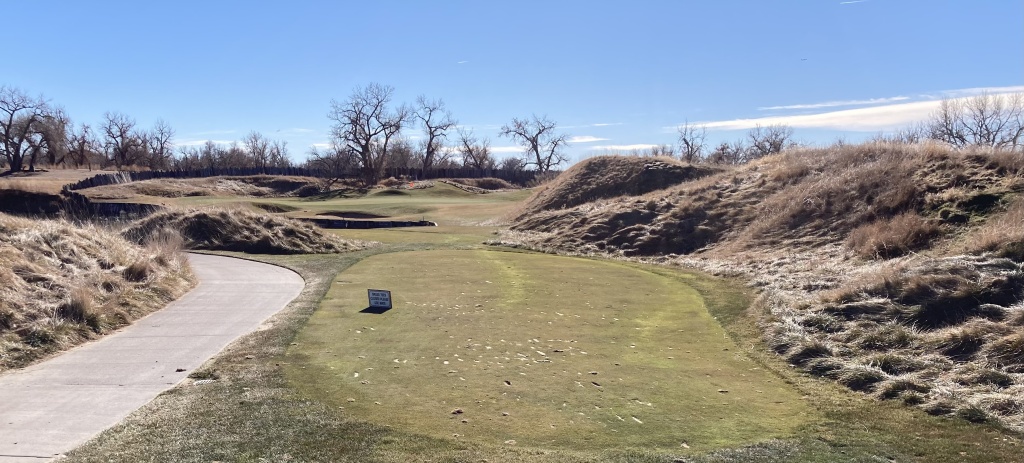Architects: Pete Dye and Perry Dye
Walkable: Yes
Highlighted Holes: 5, 7, 9, 14
Lowlighted Holes: 15
Pete and Perry Dye have their names on Riverdale Dunes, but do a little digging and you’ll learn that much of the shaping and design was done by a budding young architect named Tom Doak, as well as current members of his team like Jim Urbina and Eric Iverson. I’ll be cribbing liberally from a Golf Club Atlas post in which Doak has commented.1 I don’t want you to think that I’m that astute of a course connoisseur just yet; the blog isn’t named Layman’s Hall for nothing.
Dunes stands out among a strong list of public access courses in the Denver area and the quality of golf you get for your money here may just outpace every single one of them. We recently played there December 30th in ideal conditions: the ground was hard, frozen, and brown making it play like the Isles courses it was modeled after. Scraggy dunes peek up along the fairways and, as long as you’re facing East, add to the sense that you might not be in Colorado anymore.

As I like to see in a course, every hole is distinct and unique and as a result, if I wanted to subject you to a much longer blog post, I could highlight a half-dozen more holes. The greens are a delight of pockets and avenues for running your ball up onto the green. Seven holes have water and on six of them it enhances the challenge by playing into your thinking off the tee. While there are dunes aplenty, there aren’t many hills on the course, and cleverly cut paths make it a favorite for walking Denverites.
Five: The fifth green is obscured from the tee by a dune at the front right. The ideal position is the left side of the fairway but it can be a challenge to convince yourself to hug the left edge. The green has two tiers, one of which is a front half-bowl that can gather run up shots and leave you with a good chance for birdie. If the pin is on the second tier, you’re looking at a three putt if you’re not careful with your approach. According to Doak:
I had shaped a simpler green there before Perry came through and told me to jazz it up, and I was a bit upset about it, so I built something extra-wild just to show him. Ironically, that green turned out to be more like the “Doak” style than anything else at Riverdale Dunes, but I never would have thought so at the time I built it.


Seven: The seventh makes good use of a large lake down the left side. The fairway is wide enough to to bail out right, but the closer you can keep it to the water, the better your angle of approach will be. This is another great green which, “is built for a run-up shot, inspired by #12 at St. Andrews among others,” but also includes a hidden back pocket that makes for a fun but difficult approach.


Nine: The ninth is a short par five, under 500 yards, and from the tee it can be tricky to tell where exactly you want to put the ball. The rough right falls away from the fairway and though the water left is not in play, the deep stuff sure is. Doak built the green as an ode to the Dell hole at Lahinch. Even if the surrounds aren’t as severe, it’s easy to see the similarities. A layup will give you a short wedge shot in and a chance at birdie; go for the green and you might find yourself hacking out of long grass or awkwardly standing on a hillside.


Fourteen: This is a short, driveable par four that I don’t think I’ve ever laid up on. It’s protected by mature trees on the left, but a draw will carry your ball into the green and a high enough fade will make them irrelevant. I’ve been told that there is room to lay up on the right with an iron and have an open approach, but can’t confirm this firsthand. The pot bunkers near the tree and in the back right of the fairway add to the charm and, frankly, it’s good to have a short, fun par four ahead of the scourge that is the fifteenth.


Fifteen: At a little over 7,000 yards, the course is the perfect length for me from the tips. While I’m not a spectacularly long hitter, with help from the altitude I can get the ball out there. There are seventeen fair golf holes that are a wonderful variety of lengths, many of which offer you options to be aggressive or lay back; and then there’s the fifteenth.
From what I can tell, the fifteenth came to Colorado on vacation from Florida and never left. The Dyes’ signature railroad ties separate the fairway from the water from tee to hole. The play is off to the right in the sliver of fairway giving you a second shot over water to a green protected by dunes. If the wind is at all into your face, your best bet may be to lay up to the tee boxes on the right, get on in three, and two putt.


The only negative thing I can say about the course (aside from 15) is that during the season, they water the crap out of what is ostensibly designed to be a links-style course. Doak has said that the best time to play the Dunes course is in the winter when the ground is frozen and he’s absolutely right. It plays like it’s designed. However, even a saturated Dunes course is still one of the best in the area.

Resources:
- Golf Club Atlas – Riverdale Dunes question for Tom Doak ↩︎
No Laying Up – Crash Course: Riverdale Dunes

Leave a comment